Annotated Bibliography: Augmented Reality and Emerging Technologies
VerifiedAdded on 2020/02/23
|11
|3043
|251
Annotated Bibliography
AI Summary
This annotated bibliography provides concise summaries of eleven articles focusing on Augmented Reality (AR) and its applications. The articles cover a wide range of topics, including the fundamental concepts of AR, its role in various fields such as education, medicine, and manufacturing, and its potential for advertising and maintenance. The bibliography explores the technical aspects of AR systems, including tracking, registration, and user interface design, and discusses the challenges and future trends in the field. Several articles highlight the benefits of AR in educational environments, emphasizing its potential to enhance learning and facilitate access to location-specific information. Furthermore, the bibliography examines the use of AR in advertising, emphasizing its potential for new-age consumer engagement and interactive marketing. Overall, the annotated bibliography provides a comprehensive overview of the current state and future directions of AR technology.
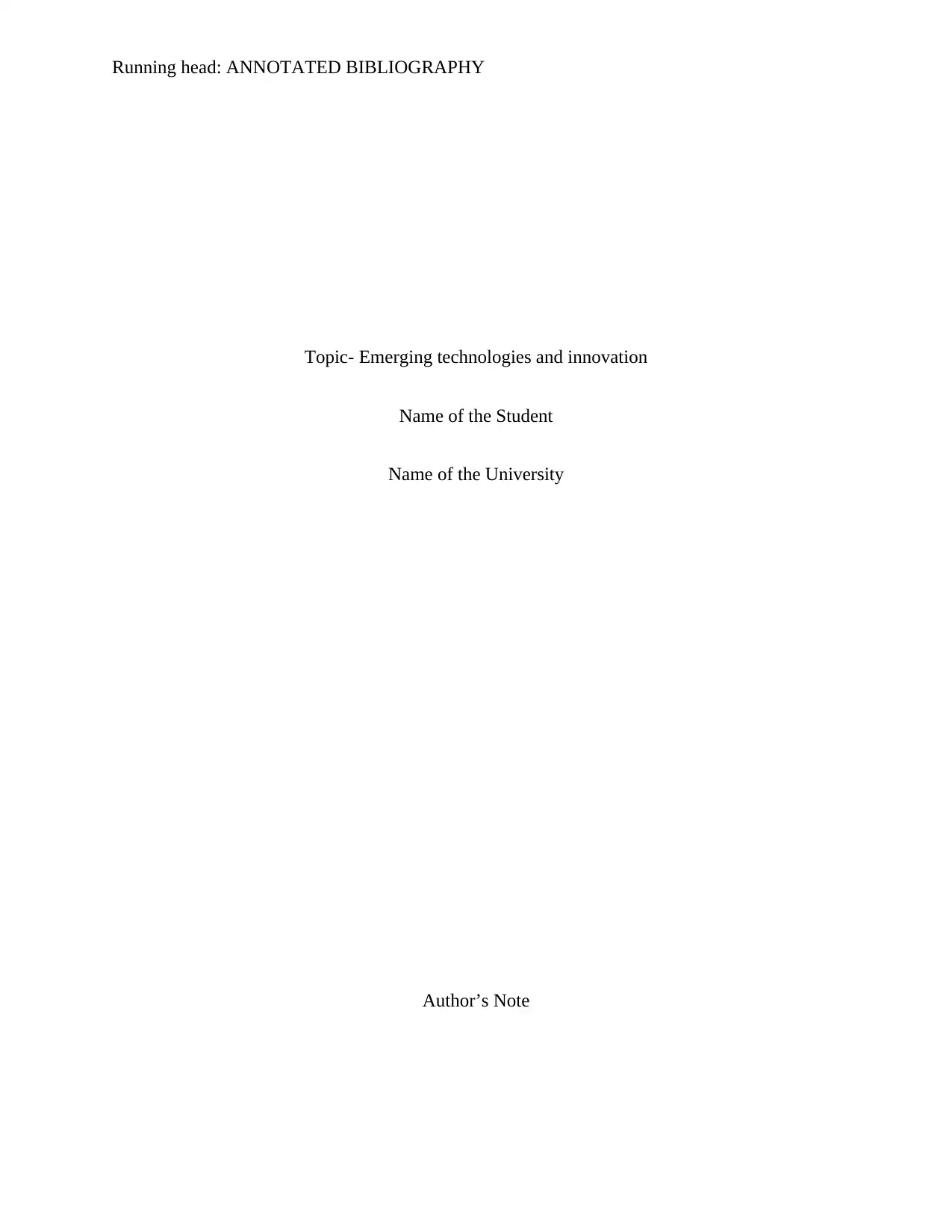
Running head: ANNOTATED BIBLIOGRAPHY
Topic- Emerging technologies and innovation
Name of the Student
Name of the University
Author’s Note
Topic- Emerging technologies and innovation
Name of the Student
Name of the University
Author’s Note
Paraphrase This Document
Need a fresh take? Get an instant paraphrase of this document with our AI Paraphraser
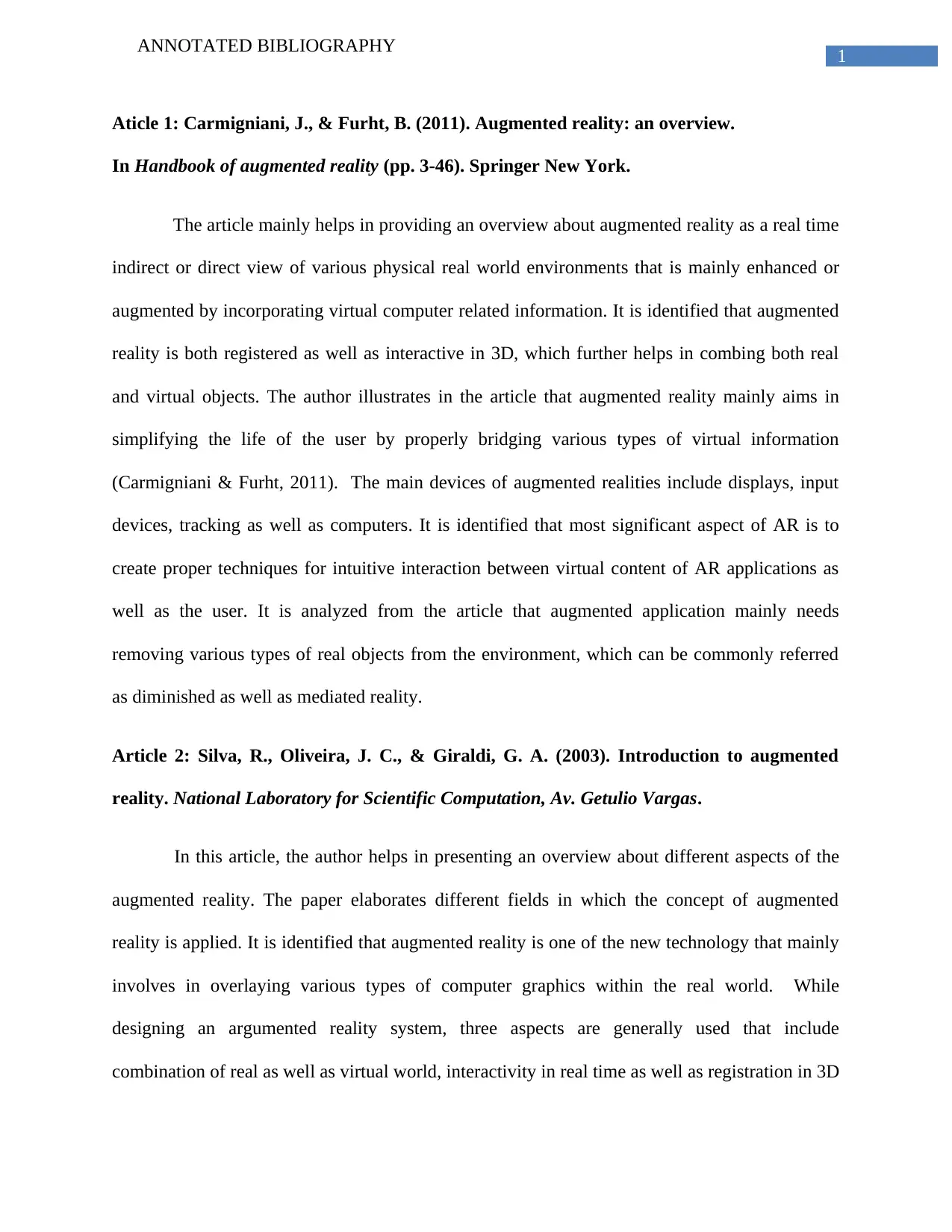
1
ANNOTATED BIBLIOGRAPHY
Aticle 1: Carmigniani, J., & Furht, B. (2011). Augmented reality: an overview.
In Handbook of augmented reality (pp. 3-46). Springer New York.
The article mainly helps in providing an overview about augmented reality as a real time
indirect or direct view of various physical real world environments that is mainly enhanced or
augmented by incorporating virtual computer related information. It is identified that augmented
reality is both registered as well as interactive in 3D, which further helps in combing both real
and virtual objects. The author illustrates in the article that augmented reality mainly aims in
simplifying the life of the user by properly bridging various types of virtual information
(Carmigniani & Furht, 2011). The main devices of augmented realities include displays, input
devices, tracking as well as computers. It is identified that most significant aspect of AR is to
create proper techniques for intuitive interaction between virtual content of AR applications as
well as the user. It is analyzed from the article that augmented application mainly needs
removing various types of real objects from the environment, which can be commonly referred
as diminished as well as mediated reality.
Article 2: Silva, R., Oliveira, J. C., & Giraldi, G. A. (2003). Introduction to augmented
reality. National Laboratory for Scientific Computation, Av. Getulio Vargas.
In this article, the author helps in presenting an overview about different aspects of the
augmented reality. The paper elaborates different fields in which the concept of augmented
reality is applied. It is identified that augmented reality is one of the new technology that mainly
involves in overlaying various types of computer graphics within the real world. While
designing an argumented reality system, three aspects are generally used that include
combination of real as well as virtual world, interactivity in real time as well as registration in 3D
ANNOTATED BIBLIOGRAPHY
Aticle 1: Carmigniani, J., & Furht, B. (2011). Augmented reality: an overview.
In Handbook of augmented reality (pp. 3-46). Springer New York.
The article mainly helps in providing an overview about augmented reality as a real time
indirect or direct view of various physical real world environments that is mainly enhanced or
augmented by incorporating virtual computer related information. It is identified that augmented
reality is both registered as well as interactive in 3D, which further helps in combing both real
and virtual objects. The author illustrates in the article that augmented reality mainly aims in
simplifying the life of the user by properly bridging various types of virtual information
(Carmigniani & Furht, 2011). The main devices of augmented realities include displays, input
devices, tracking as well as computers. It is identified that most significant aspect of AR is to
create proper techniques for intuitive interaction between virtual content of AR applications as
well as the user. It is analyzed from the article that augmented application mainly needs
removing various types of real objects from the environment, which can be commonly referred
as diminished as well as mediated reality.
Article 2: Silva, R., Oliveira, J. C., & Giraldi, G. A. (2003). Introduction to augmented
reality. National Laboratory for Scientific Computation, Av. Getulio Vargas.
In this article, the author helps in presenting an overview about different aspects of the
augmented reality. The paper elaborates different fields in which the concept of augmented
reality is applied. It is identified that augmented reality is one of the new technology that mainly
involves in overlaying various types of computer graphics within the real world. While
designing an argumented reality system, three aspects are generally used that include
combination of real as well as virtual world, interactivity in real time as well as registration in 3D
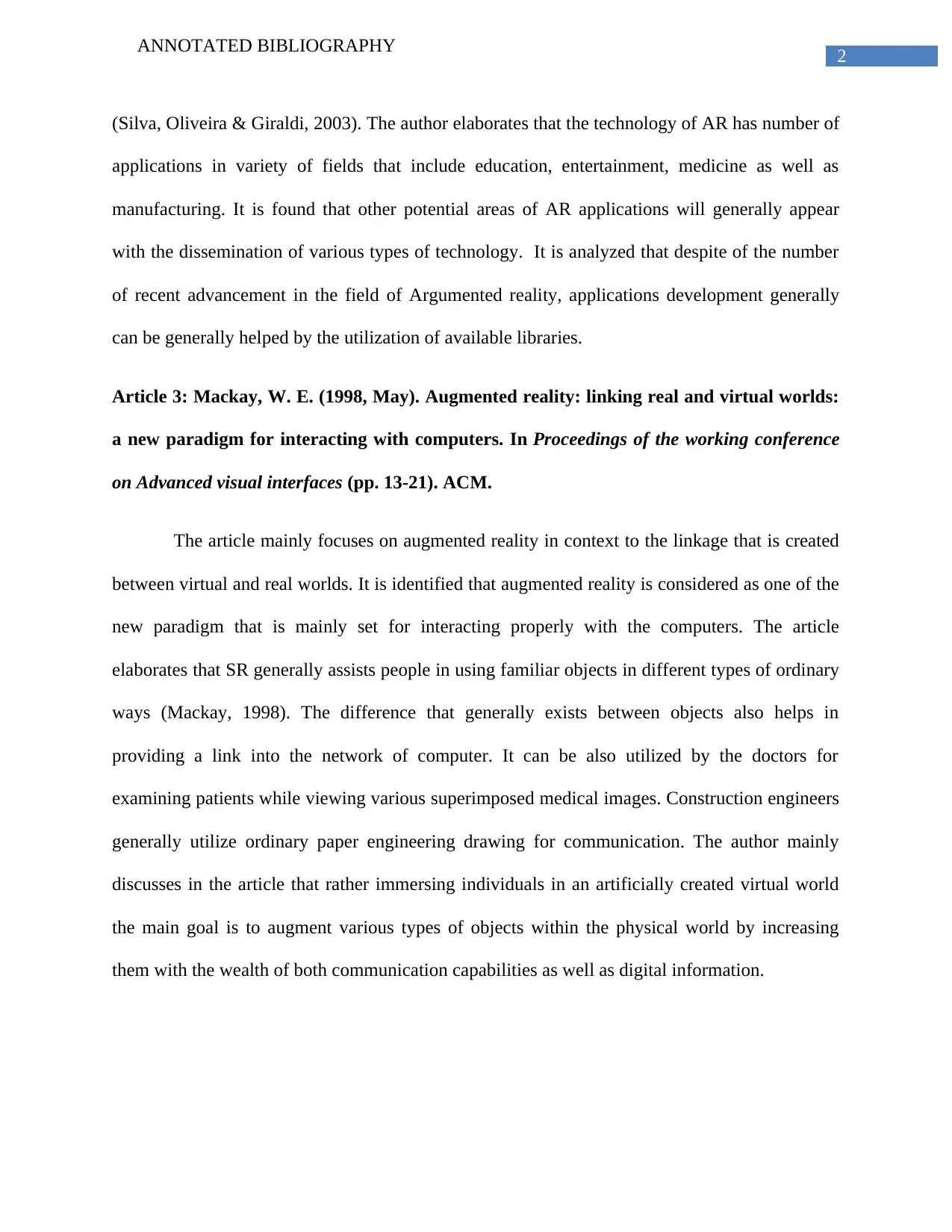
2
ANNOTATED BIBLIOGRAPHY
(Silva, Oliveira & Giraldi, 2003). The author elaborates that the technology of AR has number of
applications in variety of fields that include education, entertainment, medicine as well as
manufacturing. It is found that other potential areas of AR applications will generally appear
with the dissemination of various types of technology. It is analyzed that despite of the number
of recent advancement in the field of Argumented reality, applications development generally
can be generally helped by the utilization of available libraries.
Article 3: Mackay, W. E. (1998, May). Augmented reality: linking real and virtual worlds:
a new paradigm for interacting with computers. In Proceedings of the working conference
on Advanced visual interfaces (pp. 13-21). ACM.
The article mainly focuses on augmented reality in context to the linkage that is created
between virtual and real worlds. It is identified that augmented reality is considered as one of the
new paradigm that is mainly set for interacting properly with the computers. The article
elaborates that SR generally assists people in using familiar objects in different types of ordinary
ways (Mackay, 1998). The difference that generally exists between objects also helps in
providing a link into the network of computer. It can be also utilized by the doctors for
examining patients while viewing various superimposed medical images. Construction engineers
generally utilize ordinary paper engineering drawing for communication. The author mainly
discusses in the article that rather immersing individuals in an artificially created virtual world
the main goal is to augment various types of objects within the physical world by increasing
them with the wealth of both communication capabilities as well as digital information.
ANNOTATED BIBLIOGRAPHY
(Silva, Oliveira & Giraldi, 2003). The author elaborates that the technology of AR has number of
applications in variety of fields that include education, entertainment, medicine as well as
manufacturing. It is found that other potential areas of AR applications will generally appear
with the dissemination of various types of technology. It is analyzed that despite of the number
of recent advancement in the field of Argumented reality, applications development generally
can be generally helped by the utilization of available libraries.
Article 3: Mackay, W. E. (1998, May). Augmented reality: linking real and virtual worlds:
a new paradigm for interacting with computers. In Proceedings of the working conference
on Advanced visual interfaces (pp. 13-21). ACM.
The article mainly focuses on augmented reality in context to the linkage that is created
between virtual and real worlds. It is identified that augmented reality is considered as one of the
new paradigm that is mainly set for interacting properly with the computers. The article
elaborates that SR generally assists people in using familiar objects in different types of ordinary
ways (Mackay, 1998). The difference that generally exists between objects also helps in
providing a link into the network of computer. It can be also utilized by the doctors for
examining patients while viewing various superimposed medical images. Construction engineers
generally utilize ordinary paper engineering drawing for communication. The author mainly
discusses in the article that rather immersing individuals in an artificially created virtual world
the main goal is to augment various types of objects within the physical world by increasing
them with the wealth of both communication capabilities as well as digital information.
⊘ This is a preview!⊘
Do you want full access?
Subscribe today to unlock all pages.

Trusted by 1+ million students worldwide
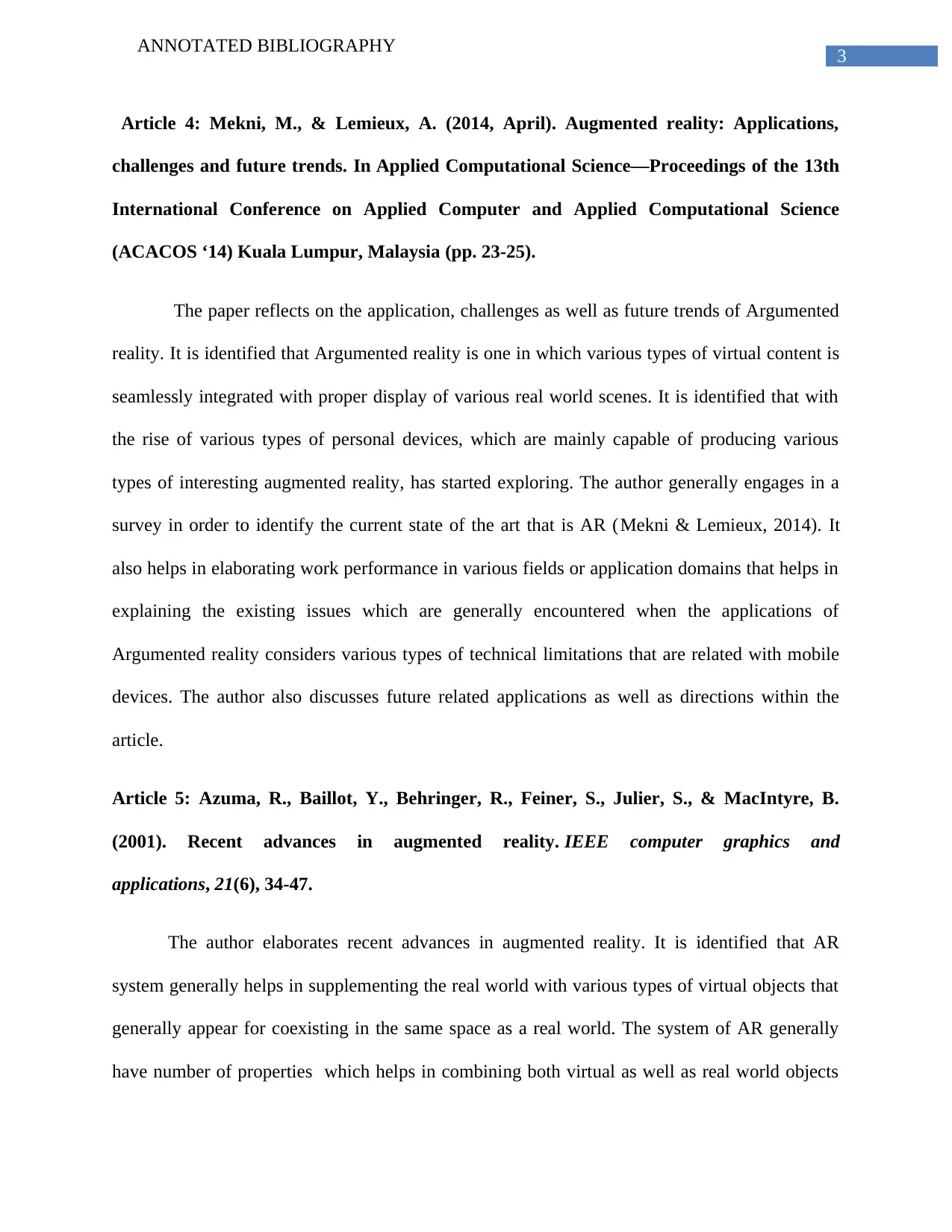
3
ANNOTATED BIBLIOGRAPHY
Article 4: Mekni, M., & Lemieux, A. (2014, April). Augmented reality: Applications,
challenges and future trends. In Applied Computational Science—Proceedings of the 13th
International Conference on Applied Computer and Applied Computational Science
(ACACOS ‘14) Kuala Lumpur, Malaysia (pp. 23-25).
The paper reflects on the application, challenges as well as future trends of Argumented
reality. It is identified that Argumented reality is one in which various types of virtual content is
seamlessly integrated with proper display of various real world scenes. It is identified that with
the rise of various types of personal devices, which are mainly capable of producing various
types of interesting augmented reality, has started exploring. The author generally engages in a
survey in order to identify the current state of the art that is AR (Mekni & Lemieux, 2014). It
also helps in elaborating work performance in various fields or application domains that helps in
explaining the existing issues which are generally encountered when the applications of
Argumented reality considers various types of technical limitations that are related with mobile
devices. The author also discusses future related applications as well as directions within the
article.
Article 5: Azuma, R., Baillot, Y., Behringer, R., Feiner, S., Julier, S., & MacIntyre, B.
(2001). Recent advances in augmented reality. IEEE computer graphics and
applications, 21(6), 34-47.
The author elaborates recent advances in augmented reality. It is identified that AR
system generally helps in supplementing the real world with various types of virtual objects that
generally appear for coexisting in the same space as a real world. The system of AR generally
have number of properties which helps in combining both virtual as well as real world objects
ANNOTATED BIBLIOGRAPHY
Article 4: Mekni, M., & Lemieux, A. (2014, April). Augmented reality: Applications,
challenges and future trends. In Applied Computational Science—Proceedings of the 13th
International Conference on Applied Computer and Applied Computational Science
(ACACOS ‘14) Kuala Lumpur, Malaysia (pp. 23-25).
The paper reflects on the application, challenges as well as future trends of Argumented
reality. It is identified that Argumented reality is one in which various types of virtual content is
seamlessly integrated with proper display of various real world scenes. It is identified that with
the rise of various types of personal devices, which are mainly capable of producing various
types of interesting augmented reality, has started exploring. The author generally engages in a
survey in order to identify the current state of the art that is AR (Mekni & Lemieux, 2014). It
also helps in elaborating work performance in various fields or application domains that helps in
explaining the existing issues which are generally encountered when the applications of
Argumented reality considers various types of technical limitations that are related with mobile
devices. The author also discusses future related applications as well as directions within the
article.
Article 5: Azuma, R., Baillot, Y., Behringer, R., Feiner, S., Julier, S., & MacIntyre, B.
(2001). Recent advances in augmented reality. IEEE computer graphics and
applications, 21(6), 34-47.
The author elaborates recent advances in augmented reality. It is identified that AR
system generally helps in supplementing the real world with various types of virtual objects that
generally appear for coexisting in the same space as a real world. The system of AR generally
have number of properties which helps in combining both virtual as well as real world objects
Paraphrase This Document
Need a fresh take? Get an instant paraphrase of this document with our AI Paraphraser
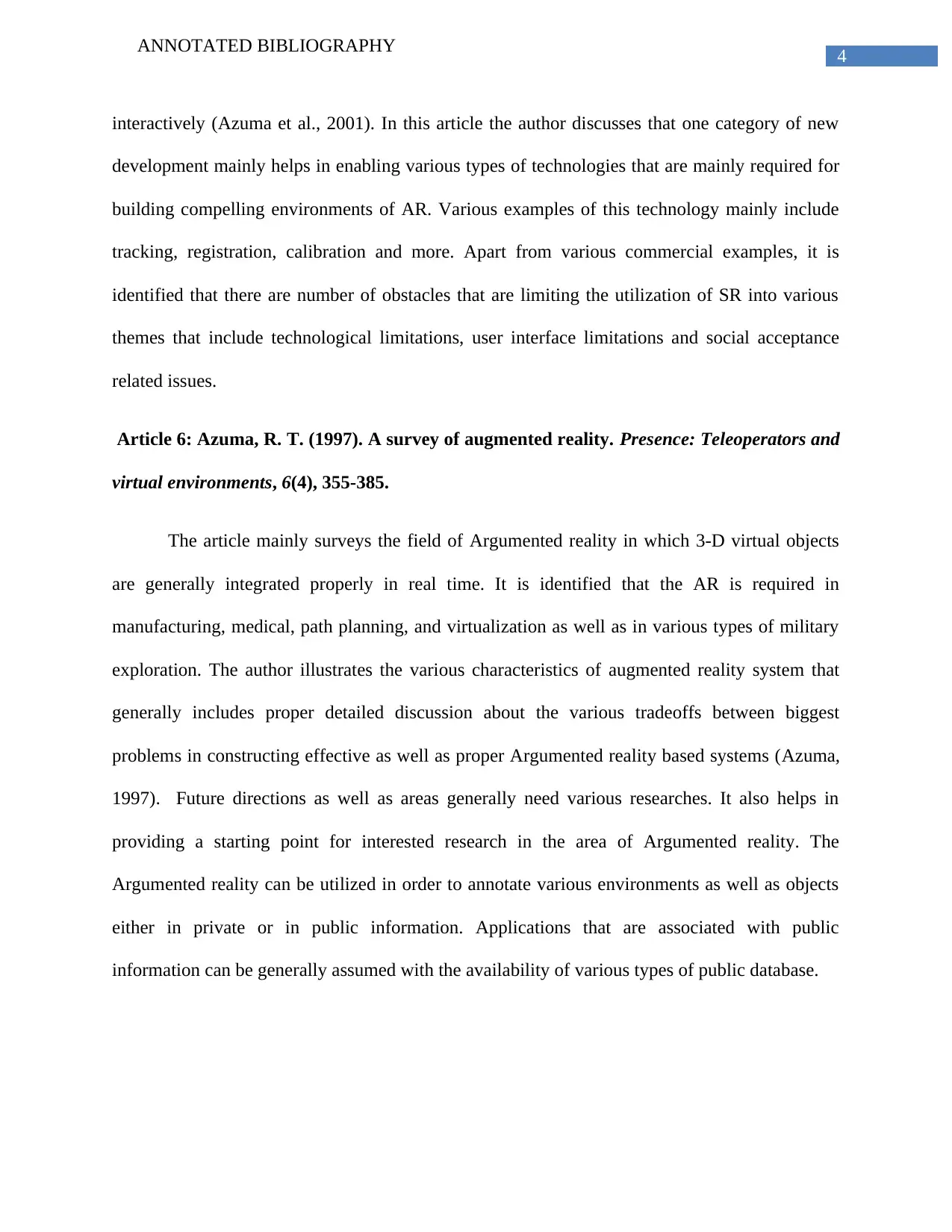
4
ANNOTATED BIBLIOGRAPHY
interactively (Azuma et al., 2001). In this article the author discusses that one category of new
development mainly helps in enabling various types of technologies that are mainly required for
building compelling environments of AR. Various examples of this technology mainly include
tracking, registration, calibration and more. Apart from various commercial examples, it is
identified that there are number of obstacles that are limiting the utilization of SR into various
themes that include technological limitations, user interface limitations and social acceptance
related issues.
Article 6: Azuma, R. T. (1997). A survey of augmented reality. Presence: Teleoperators and
virtual environments, 6(4), 355-385.
The article mainly surveys the field of Argumented reality in which 3-D virtual objects
are generally integrated properly in real time. It is identified that the AR is required in
manufacturing, medical, path planning, and virtualization as well as in various types of military
exploration. The author illustrates the various characteristics of augmented reality system that
generally includes proper detailed discussion about the various tradeoffs between biggest
problems in constructing effective as well as proper Argumented reality based systems (Azuma,
1997). Future directions as well as areas generally need various researches. It also helps in
providing a starting point for interested research in the area of Argumented reality. The
Argumented reality can be utilized in order to annotate various environments as well as objects
either in private or in public information. Applications that are associated with public
information can be generally assumed with the availability of various types of public database.
ANNOTATED BIBLIOGRAPHY
interactively (Azuma et al., 2001). In this article the author discusses that one category of new
development mainly helps in enabling various types of technologies that are mainly required for
building compelling environments of AR. Various examples of this technology mainly include
tracking, registration, calibration and more. Apart from various commercial examples, it is
identified that there are number of obstacles that are limiting the utilization of SR into various
themes that include technological limitations, user interface limitations and social acceptance
related issues.
Article 6: Azuma, R. T. (1997). A survey of augmented reality. Presence: Teleoperators and
virtual environments, 6(4), 355-385.
The article mainly surveys the field of Argumented reality in which 3-D virtual objects
are generally integrated properly in real time. It is identified that the AR is required in
manufacturing, medical, path planning, and virtualization as well as in various types of military
exploration. The author illustrates the various characteristics of augmented reality system that
generally includes proper detailed discussion about the various tradeoffs between biggest
problems in constructing effective as well as proper Argumented reality based systems (Azuma,
1997). Future directions as well as areas generally need various researches. It also helps in
providing a starting point for interested research in the area of Argumented reality. The
Argumented reality can be utilized in order to annotate various environments as well as objects
either in private or in public information. Applications that are associated with public
information can be generally assumed with the availability of various types of public database.
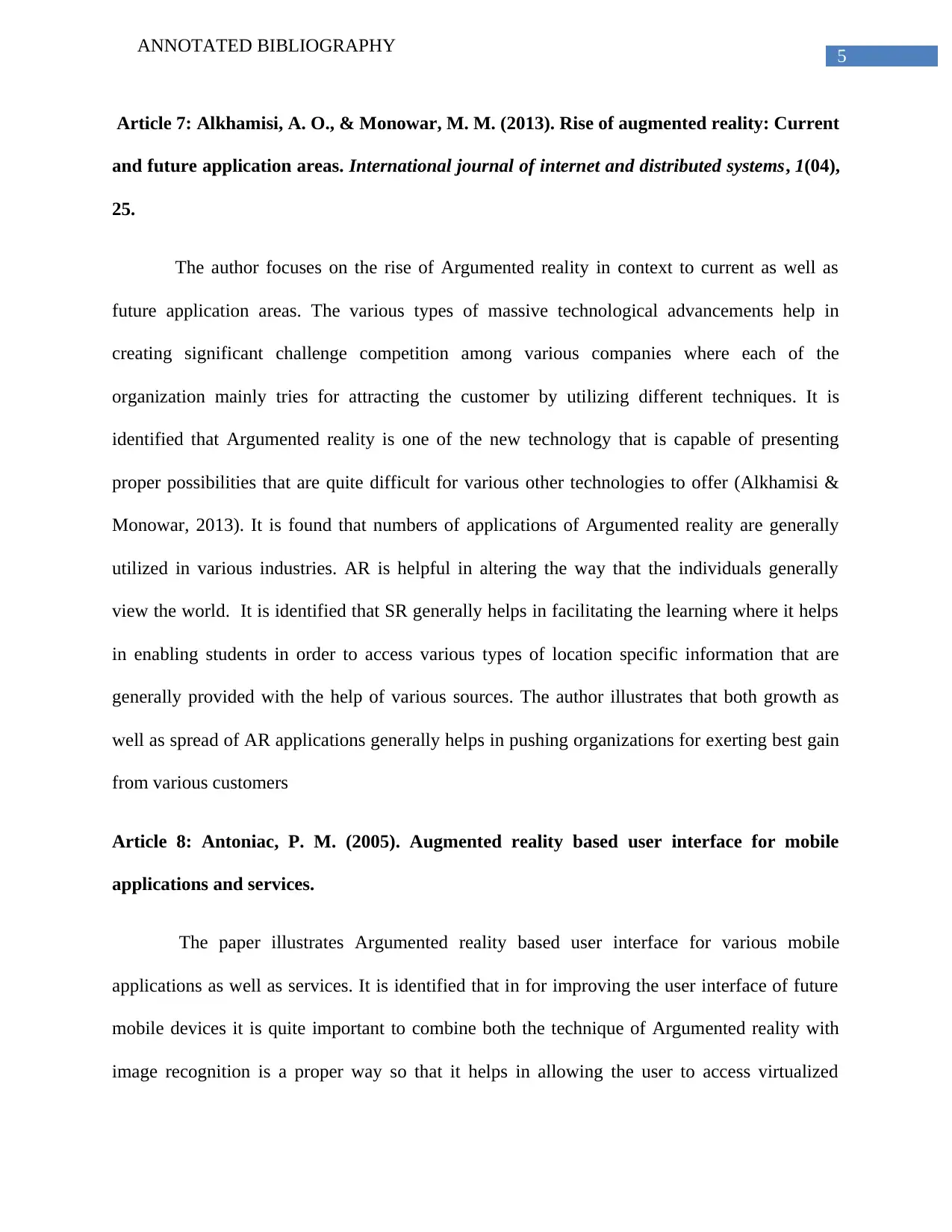
5
ANNOTATED BIBLIOGRAPHY
Article 7: Alkhamisi, A. O., & Monowar, M. M. (2013). Rise of augmented reality: Current
and future application areas. International journal of internet and distributed systems, 1(04),
25.
The author focuses on the rise of Argumented reality in context to current as well as
future application areas. The various types of massive technological advancements help in
creating significant challenge competition among various companies where each of the
organization mainly tries for attracting the customer by utilizing different techniques. It is
identified that Argumented reality is one of the new technology that is capable of presenting
proper possibilities that are quite difficult for various other technologies to offer (Alkhamisi &
Monowar, 2013). It is found that numbers of applications of Argumented reality are generally
utilized in various industries. AR is helpful in altering the way that the individuals generally
view the world. It is identified that SR generally helps in facilitating the learning where it helps
in enabling students in order to access various types of location specific information that are
generally provided with the help of various sources. The author illustrates that both growth as
well as spread of AR applications generally helps in pushing organizations for exerting best gain
from various customers
Article 8: Antoniac, P. M. (2005). Augmented reality based user interface for mobile
applications and services.
The paper illustrates Argumented reality based user interface for various mobile
applications as well as services. It is identified that in for improving the user interface of future
mobile devices it is quite important to combine both the technique of Argumented reality with
image recognition is a proper way so that it helps in allowing the user to access virtualized
ANNOTATED BIBLIOGRAPHY
Article 7: Alkhamisi, A. O., & Monowar, M. M. (2013). Rise of augmented reality: Current
and future application areas. International journal of internet and distributed systems, 1(04),
25.
The author focuses on the rise of Argumented reality in context to current as well as
future application areas. The various types of massive technological advancements help in
creating significant challenge competition among various companies where each of the
organization mainly tries for attracting the customer by utilizing different techniques. It is
identified that Argumented reality is one of the new technology that is capable of presenting
proper possibilities that are quite difficult for various other technologies to offer (Alkhamisi &
Monowar, 2013). It is found that numbers of applications of Argumented reality are generally
utilized in various industries. AR is helpful in altering the way that the individuals generally
view the world. It is identified that SR generally helps in facilitating the learning where it helps
in enabling students in order to access various types of location specific information that are
generally provided with the help of various sources. The author illustrates that both growth as
well as spread of AR applications generally helps in pushing organizations for exerting best gain
from various customers
Article 8: Antoniac, P. M. (2005). Augmented reality based user interface for mobile
applications and services.
The paper illustrates Argumented reality based user interface for various mobile
applications as well as services. It is identified that in for improving the user interface of future
mobile devices it is quite important to combine both the technique of Argumented reality with
image recognition is a proper way so that it helps in allowing the user to access virtualized
⊘ This is a preview!⊘
Do you want full access?
Subscribe today to unlock all pages.

Trusted by 1+ million students worldwide
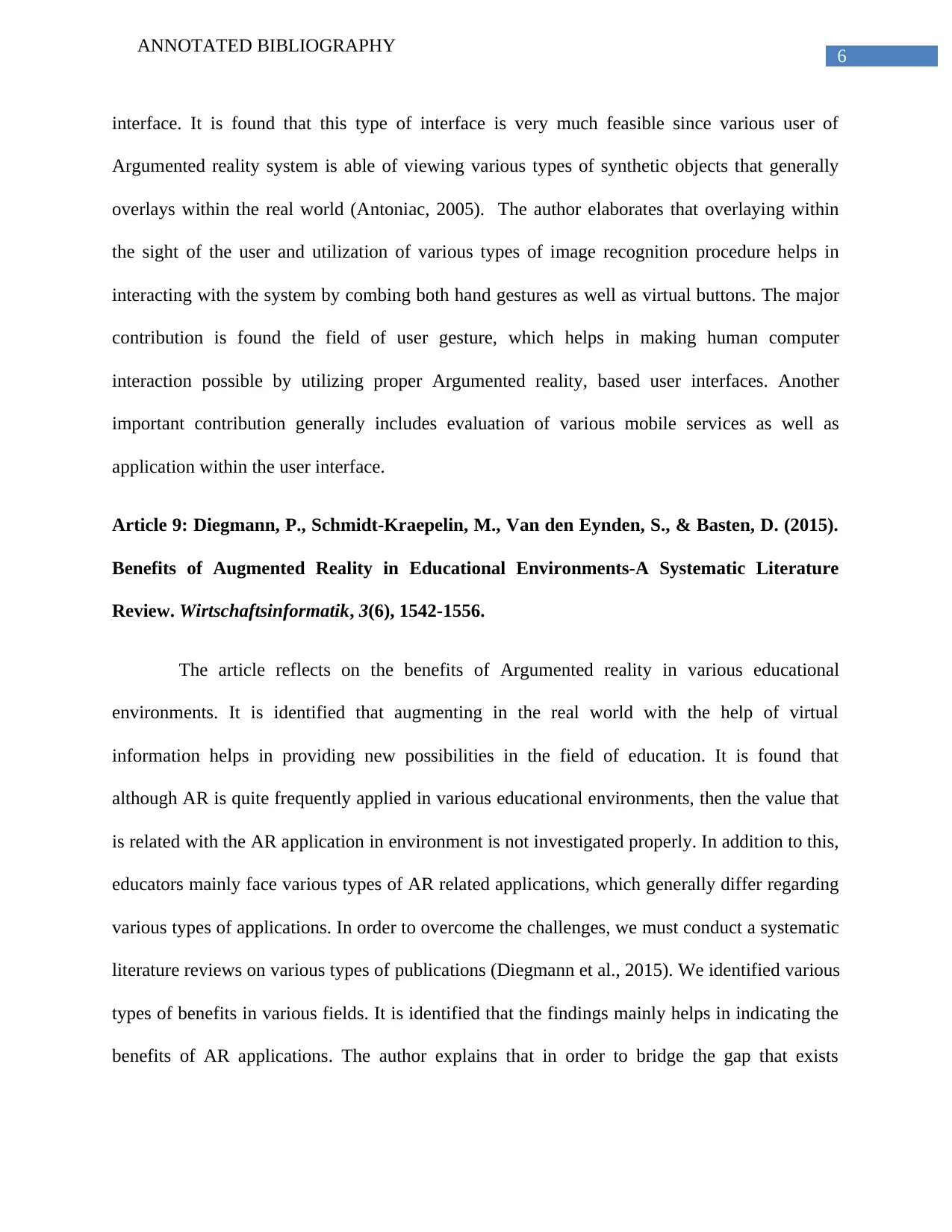
6
ANNOTATED BIBLIOGRAPHY
interface. It is found that this type of interface is very much feasible since various user of
Argumented reality system is able of viewing various types of synthetic objects that generally
overlays within the real world (Antoniac, 2005). The author elaborates that overlaying within
the sight of the user and utilization of various types of image recognition procedure helps in
interacting with the system by combing both hand gestures as well as virtual buttons. The major
contribution is found the field of user gesture, which helps in making human computer
interaction possible by utilizing proper Argumented reality, based user interfaces. Another
important contribution generally includes evaluation of various mobile services as well as
application within the user interface.
Article 9: Diegmann, P., Schmidt-Kraepelin, M., Van den Eynden, S., & Basten, D. (2015).
Benefits of Augmented Reality in Educational Environments-A Systematic Literature
Review. Wirtschaftsinformatik, 3(6), 1542-1556.
The article reflects on the benefits of Argumented reality in various educational
environments. It is identified that augmenting in the real world with the help of virtual
information helps in providing new possibilities in the field of education. It is found that
although AR is quite frequently applied in various educational environments, then the value that
is related with the AR application in environment is not investigated properly. In addition to this,
educators mainly face various types of AR related applications, which generally differ regarding
various types of applications. In order to overcome the challenges, we must conduct a systematic
literature reviews on various types of publications (Diegmann et al., 2015). We identified various
types of benefits in various fields. It is identified that the findings mainly helps in indicating the
benefits of AR applications. The author explains that in order to bridge the gap that exists
ANNOTATED BIBLIOGRAPHY
interface. It is found that this type of interface is very much feasible since various user of
Argumented reality system is able of viewing various types of synthetic objects that generally
overlays within the real world (Antoniac, 2005). The author elaborates that overlaying within
the sight of the user and utilization of various types of image recognition procedure helps in
interacting with the system by combing both hand gestures as well as virtual buttons. The major
contribution is found the field of user gesture, which helps in making human computer
interaction possible by utilizing proper Argumented reality, based user interfaces. Another
important contribution generally includes evaluation of various mobile services as well as
application within the user interface.
Article 9: Diegmann, P., Schmidt-Kraepelin, M., Van den Eynden, S., & Basten, D. (2015).
Benefits of Augmented Reality in Educational Environments-A Systematic Literature
Review. Wirtschaftsinformatik, 3(6), 1542-1556.
The article reflects on the benefits of Argumented reality in various educational
environments. It is identified that augmenting in the real world with the help of virtual
information helps in providing new possibilities in the field of education. It is found that
although AR is quite frequently applied in various educational environments, then the value that
is related with the AR application in environment is not investigated properly. In addition to this,
educators mainly face various types of AR related applications, which generally differ regarding
various types of applications. In order to overcome the challenges, we must conduct a systematic
literature reviews on various types of publications (Diegmann et al., 2015). We identified various
types of benefits in various fields. It is identified that the findings mainly helps in indicating the
benefits of AR applications. The author explains that in order to bridge the gap that exists
Paraphrase This Document
Need a fresh take? Get an instant paraphrase of this document with our AI Paraphraser
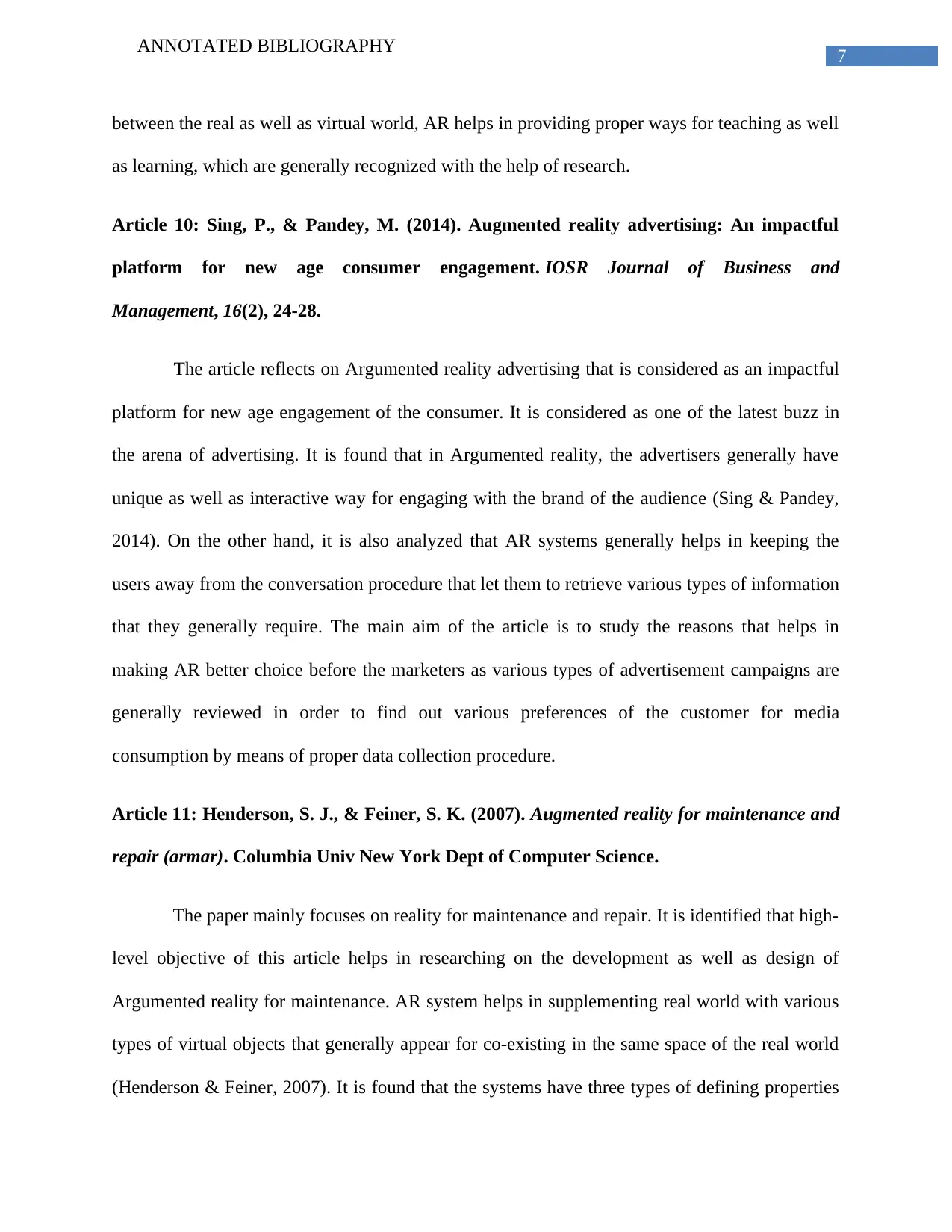
7
ANNOTATED BIBLIOGRAPHY
between the real as well as virtual world, AR helps in providing proper ways for teaching as well
as learning, which are generally recognized with the help of research.
Article 10: Sing, P., & Pandey, M. (2014). Augmented reality advertising: An impactful
platform for new age consumer engagement. IOSR Journal of Business and
Management, 16(2), 24-28.
The article reflects on Argumented reality advertising that is considered as an impactful
platform for new age engagement of the consumer. It is considered as one of the latest buzz in
the arena of advertising. It is found that in Argumented reality, the advertisers generally have
unique as well as interactive way for engaging with the brand of the audience (Sing & Pandey,
2014). On the other hand, it is also analyzed that AR systems generally helps in keeping the
users away from the conversation procedure that let them to retrieve various types of information
that they generally require. The main aim of the article is to study the reasons that helps in
making AR better choice before the marketers as various types of advertisement campaigns are
generally reviewed in order to find out various preferences of the customer for media
consumption by means of proper data collection procedure.
Article 11: Henderson, S. J., & Feiner, S. K. (2007). Augmented reality for maintenance and
repair (armar). Columbia Univ New York Dept of Computer Science.
The paper mainly focuses on reality for maintenance and repair. It is identified that high-
level objective of this article helps in researching on the development as well as design of
Argumented reality for maintenance. AR system helps in supplementing real world with various
types of virtual objects that generally appear for co-existing in the same space of the real world
(Henderson & Feiner, 2007). It is found that the systems have three types of defining properties
ANNOTATED BIBLIOGRAPHY
between the real as well as virtual world, AR helps in providing proper ways for teaching as well
as learning, which are generally recognized with the help of research.
Article 10: Sing, P., & Pandey, M. (2014). Augmented reality advertising: An impactful
platform for new age consumer engagement. IOSR Journal of Business and
Management, 16(2), 24-28.
The article reflects on Argumented reality advertising that is considered as an impactful
platform for new age engagement of the consumer. It is considered as one of the latest buzz in
the arena of advertising. It is found that in Argumented reality, the advertisers generally have
unique as well as interactive way for engaging with the brand of the audience (Sing & Pandey,
2014). On the other hand, it is also analyzed that AR systems generally helps in keeping the
users away from the conversation procedure that let them to retrieve various types of information
that they generally require. The main aim of the article is to study the reasons that helps in
making AR better choice before the marketers as various types of advertisement campaigns are
generally reviewed in order to find out various preferences of the customer for media
consumption by means of proper data collection procedure.
Article 11: Henderson, S. J., & Feiner, S. K. (2007). Augmented reality for maintenance and
repair (armar). Columbia Univ New York Dept of Computer Science.
The paper mainly focuses on reality for maintenance and repair. It is identified that high-
level objective of this article helps in researching on the development as well as design of
Argumented reality for maintenance. AR system helps in supplementing real world with various
types of virtual objects that generally appear for co-existing in the same space of the real world
(Henderson & Feiner, 2007). It is found that the systems have three types of defining properties
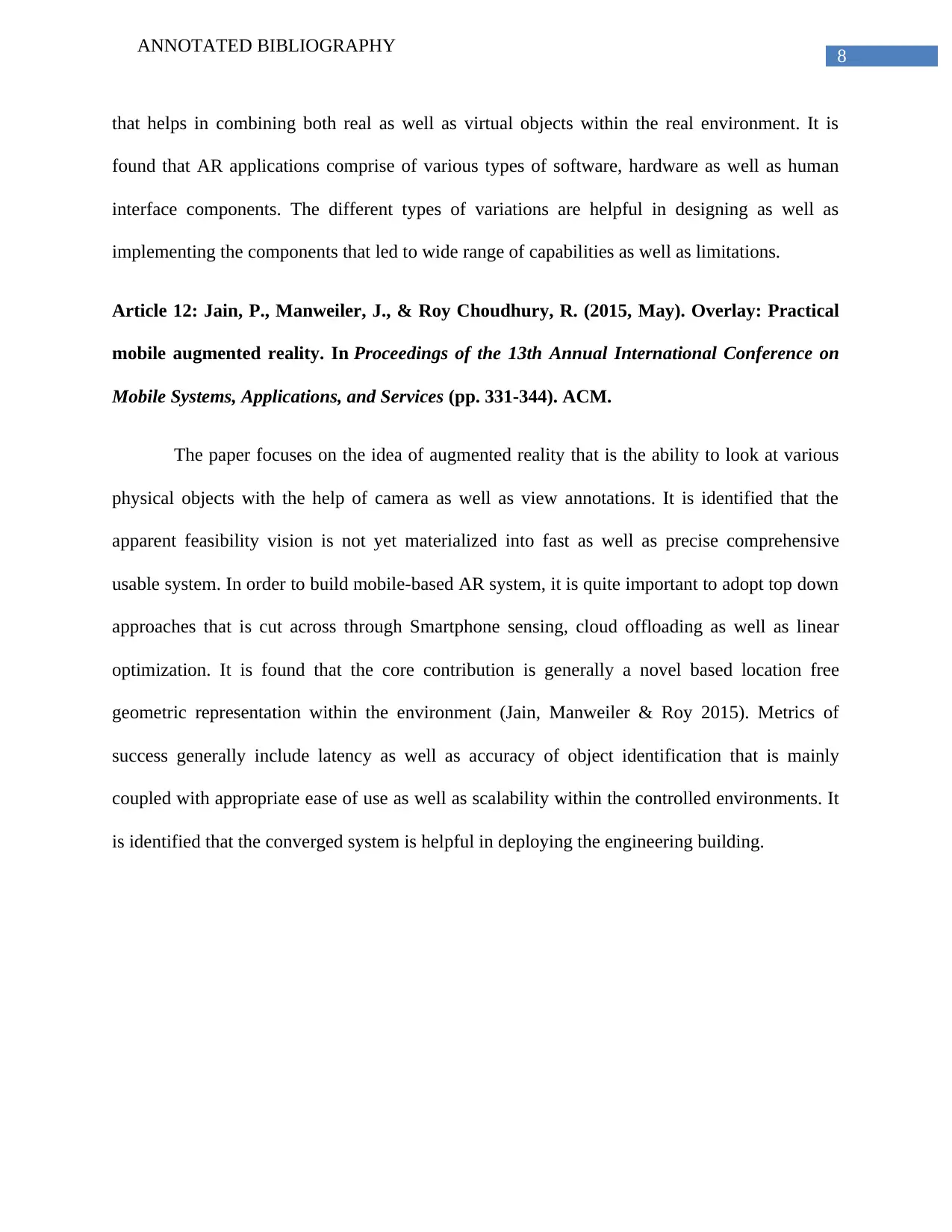
8
ANNOTATED BIBLIOGRAPHY
that helps in combining both real as well as virtual objects within the real environment. It is
found that AR applications comprise of various types of software, hardware as well as human
interface components. The different types of variations are helpful in designing as well as
implementing the components that led to wide range of capabilities as well as limitations.
Article 12: Jain, P., Manweiler, J., & Roy Choudhury, R. (2015, May). Overlay: Practical
mobile augmented reality. In Proceedings of the 13th Annual International Conference on
Mobile Systems, Applications, and Services (pp. 331-344). ACM.
The paper focuses on the idea of augmented reality that is the ability to look at various
physical objects with the help of camera as well as view annotations. It is identified that the
apparent feasibility vision is not yet materialized into fast as well as precise comprehensive
usable system. In order to build mobile-based AR system, it is quite important to adopt top down
approaches that is cut across through Smartphone sensing, cloud offloading as well as linear
optimization. It is found that the core contribution is generally a novel based location free
geometric representation within the environment (Jain, Manweiler & Roy 2015). Metrics of
success generally include latency as well as accuracy of object identification that is mainly
coupled with appropriate ease of use as well as scalability within the controlled environments. It
is identified that the converged system is helpful in deploying the engineering building.
ANNOTATED BIBLIOGRAPHY
that helps in combining both real as well as virtual objects within the real environment. It is
found that AR applications comprise of various types of software, hardware as well as human
interface components. The different types of variations are helpful in designing as well as
implementing the components that led to wide range of capabilities as well as limitations.
Article 12: Jain, P., Manweiler, J., & Roy Choudhury, R. (2015, May). Overlay: Practical
mobile augmented reality. In Proceedings of the 13th Annual International Conference on
Mobile Systems, Applications, and Services (pp. 331-344). ACM.
The paper focuses on the idea of augmented reality that is the ability to look at various
physical objects with the help of camera as well as view annotations. It is identified that the
apparent feasibility vision is not yet materialized into fast as well as precise comprehensive
usable system. In order to build mobile-based AR system, it is quite important to adopt top down
approaches that is cut across through Smartphone sensing, cloud offloading as well as linear
optimization. It is found that the core contribution is generally a novel based location free
geometric representation within the environment (Jain, Manweiler & Roy 2015). Metrics of
success generally include latency as well as accuracy of object identification that is mainly
coupled with appropriate ease of use as well as scalability within the controlled environments. It
is identified that the converged system is helpful in deploying the engineering building.
⊘ This is a preview!⊘
Do you want full access?
Subscribe today to unlock all pages.

Trusted by 1+ million students worldwide
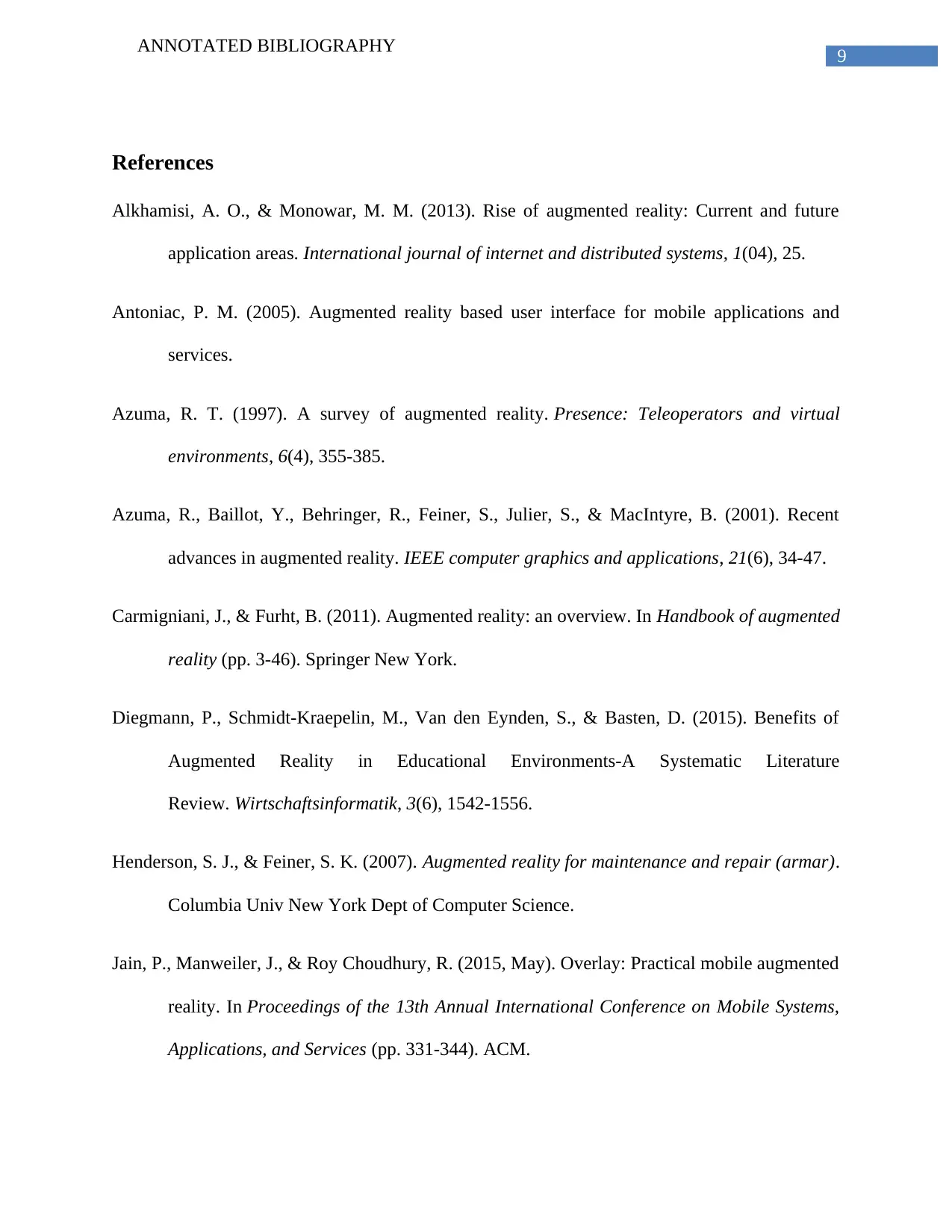
9
ANNOTATED BIBLIOGRAPHY
References
Alkhamisi, A. O., & Monowar, M. M. (2013). Rise of augmented reality: Current and future
application areas. International journal of internet and distributed systems, 1(04), 25.
Antoniac, P. M. (2005). Augmented reality based user interface for mobile applications and
services.
Azuma, R. T. (1997). A survey of augmented reality. Presence: Teleoperators and virtual
environments, 6(4), 355-385.
Azuma, R., Baillot, Y., Behringer, R., Feiner, S., Julier, S., & MacIntyre, B. (2001). Recent
advances in augmented reality. IEEE computer graphics and applications, 21(6), 34-47.
Carmigniani, J., & Furht, B. (2011). Augmented reality: an overview. In Handbook of augmented
reality (pp. 3-46). Springer New York.
Diegmann, P., Schmidt-Kraepelin, M., Van den Eynden, S., & Basten, D. (2015). Benefits of
Augmented Reality in Educational Environments-A Systematic Literature
Review. Wirtschaftsinformatik, 3(6), 1542-1556.
Henderson, S. J., & Feiner, S. K. (2007). Augmented reality for maintenance and repair (armar).
Columbia Univ New York Dept of Computer Science.
Jain, P., Manweiler, J., & Roy Choudhury, R. (2015, May). Overlay: Practical mobile augmented
reality. In Proceedings of the 13th Annual International Conference on Mobile Systems,
Applications, and Services (pp. 331-344). ACM.
ANNOTATED BIBLIOGRAPHY
References
Alkhamisi, A. O., & Monowar, M. M. (2013). Rise of augmented reality: Current and future
application areas. International journal of internet and distributed systems, 1(04), 25.
Antoniac, P. M. (2005). Augmented reality based user interface for mobile applications and
services.
Azuma, R. T. (1997). A survey of augmented reality. Presence: Teleoperators and virtual
environments, 6(4), 355-385.
Azuma, R., Baillot, Y., Behringer, R., Feiner, S., Julier, S., & MacIntyre, B. (2001). Recent
advances in augmented reality. IEEE computer graphics and applications, 21(6), 34-47.
Carmigniani, J., & Furht, B. (2011). Augmented reality: an overview. In Handbook of augmented
reality (pp. 3-46). Springer New York.
Diegmann, P., Schmidt-Kraepelin, M., Van den Eynden, S., & Basten, D. (2015). Benefits of
Augmented Reality in Educational Environments-A Systematic Literature
Review. Wirtschaftsinformatik, 3(6), 1542-1556.
Henderson, S. J., & Feiner, S. K. (2007). Augmented reality for maintenance and repair (armar).
Columbia Univ New York Dept of Computer Science.
Jain, P., Manweiler, J., & Roy Choudhury, R. (2015, May). Overlay: Practical mobile augmented
reality. In Proceedings of the 13th Annual International Conference on Mobile Systems,
Applications, and Services (pp. 331-344). ACM.
Paraphrase This Document
Need a fresh take? Get an instant paraphrase of this document with our AI Paraphraser
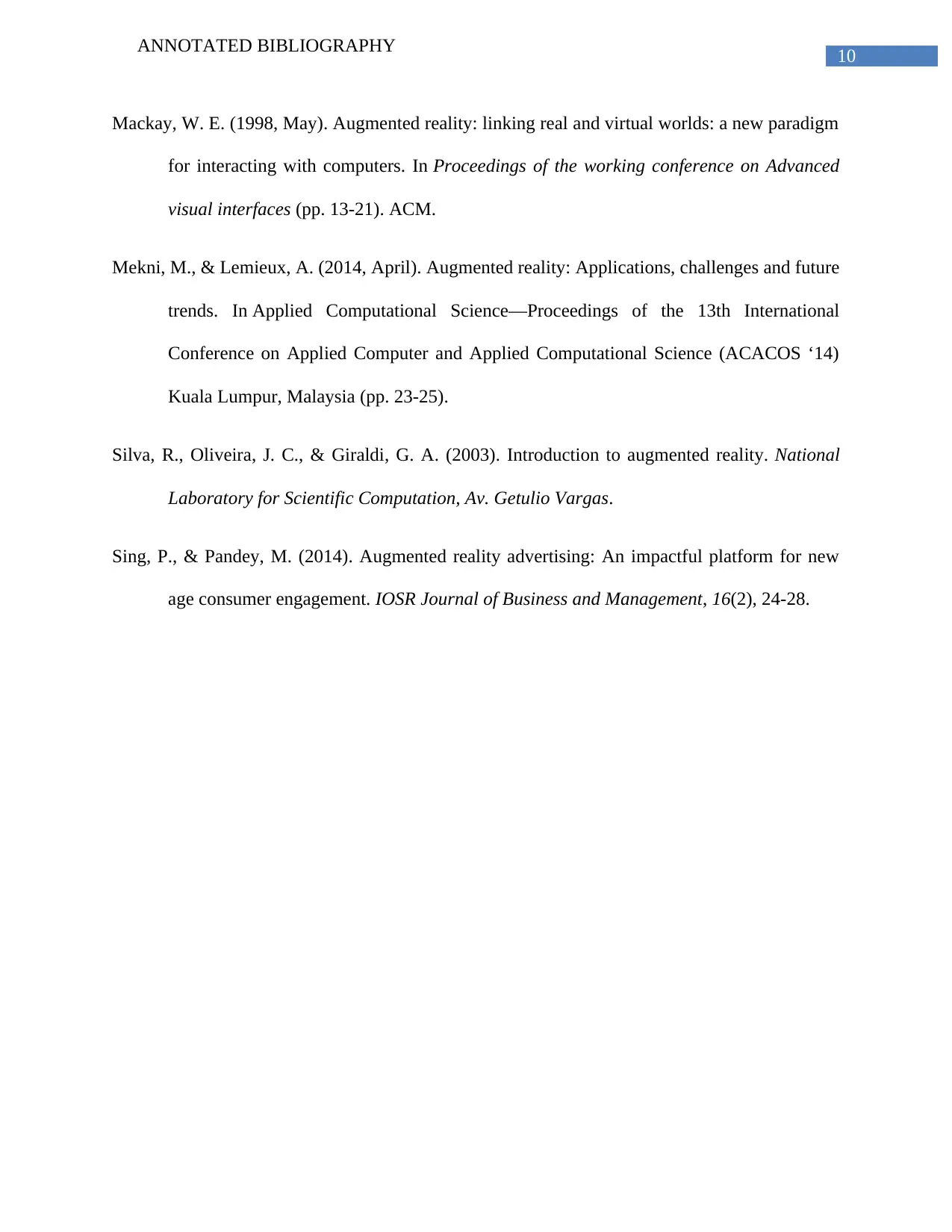
10
ANNOTATED BIBLIOGRAPHY
Mackay, W. E. (1998, May). Augmented reality: linking real and virtual worlds: a new paradigm
for interacting with computers. In Proceedings of the working conference on Advanced
visual interfaces (pp. 13-21). ACM.
Mekni, M., & Lemieux, A. (2014, April). Augmented reality: Applications, challenges and future
trends. In Applied Computational Science—Proceedings of the 13th International
Conference on Applied Computer and Applied Computational Science (ACACOS ‘14)
Kuala Lumpur, Malaysia (pp. 23-25).
Silva, R., Oliveira, J. C., & Giraldi, G. A. (2003). Introduction to augmented reality. National
Laboratory for Scientific Computation, Av. Getulio Vargas.
Sing, P., & Pandey, M. (2014). Augmented reality advertising: An impactful platform for new
age consumer engagement. IOSR Journal of Business and Management, 16(2), 24-28.
ANNOTATED BIBLIOGRAPHY
Mackay, W. E. (1998, May). Augmented reality: linking real and virtual worlds: a new paradigm
for interacting with computers. In Proceedings of the working conference on Advanced
visual interfaces (pp. 13-21). ACM.
Mekni, M., & Lemieux, A. (2014, April). Augmented reality: Applications, challenges and future
trends. In Applied Computational Science—Proceedings of the 13th International
Conference on Applied Computer and Applied Computational Science (ACACOS ‘14)
Kuala Lumpur, Malaysia (pp. 23-25).
Silva, R., Oliveira, J. C., & Giraldi, G. A. (2003). Introduction to augmented reality. National
Laboratory for Scientific Computation, Av. Getulio Vargas.
Sing, P., & Pandey, M. (2014). Augmented reality advertising: An impactful platform for new
age consumer engagement. IOSR Journal of Business and Management, 16(2), 24-28.
1 out of 11
Related Documents
Your All-in-One AI-Powered Toolkit for Academic Success.
+13062052269
info@desklib.com
Available 24*7 on WhatsApp / Email
![[object Object]](/_next/static/media/star-bottom.7253800d.svg)
Unlock your academic potential
Copyright © 2020–2025 A2Z Services. All Rights Reserved. Developed and managed by ZUCOL.





